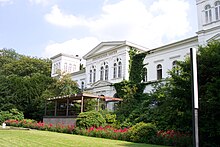London Zoo, previously known as ZSL London Zoo or London Zoological Gardens and sometimes called Regent's Park Zoo, is the world's oldest scientific zoo. It was opened in London on 27 April 1828, and was originally intended to be used as a collection for scientific study. In 1831 or 1832, the animals of the Tower of London menagerie were transferred to the zoo's collection. It was opened to the public in 1847. As of December 2022, it houses a collection of 14,926 individuals, making it one of the largest collections in the United Kingdom.

Hanover Zoo is located in the city centre, or Mitte borough, of Hanover, Germany. The zoo was established on 4 May 1865, and comprises an area of 22 hectares. It contains about 3,414 animals in 237 species, which are cared for by more than 400 employees in the summer season.
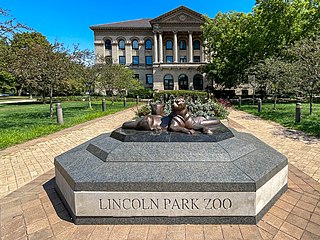
Lincoln Park Zoo, also known as Lincoln Park Zoological Gardens, is a 35-acre (14 ha) zoo in Lincoln Park, Chicago, Illinois. The zoo was founded in 1868, making it the fourth oldest zoo in North America. It is also one of a few free admission zoos in all of North America. The zoo is an accredited member of the Association of Zoos and Aquariums (AZA). The zoo also became an accredited arboretum in 2019.

Hellabrunn Zoo is a 40 hectare zoological garden in the Bavarian capital of Munich. The zoo is situated on the right bank of the river Isar, in the southern part of Munich near the quarter of Thalkirchen.

The Berlin Zoological Garden is the oldest surviving and best-known zoo in Germany. Opened in 1844, it covers 35 hectares and is located in Berlin's Tiergarten. With about 1,380 different species and over 20,200 animals, the zoo presents one of the most comprehensive collections of species in the world.
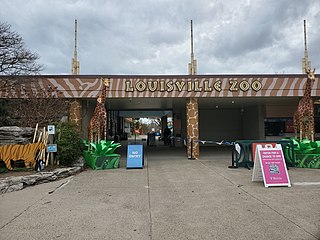
The Louisville Zoological Gardens, commonly known as the Louisville Zoo, is a 134-acre (54 ha) zoo in Louisville, Kentucky, situated in the city's Poplar Level neighborhood. Founded in 1969, the "State Zoo of Kentucky" currently exhibits over 1,200 animals in naturalistic and mixed animal settings representing both geographical areas and Biomes or habitats.

Wilhelma is a zoological-botanical garden in Stuttgart in the Bad Cannstatt district in the north of the city on the grounds of a historic castle. Wilhelma Zoo is one of the most popular tourist destinations in Baden-Württemberg, seeing more than 2 million visitors annually.

The Aktiengesellschaft Cologne Zoological Garden is the zoo of Cologne, Germany. Being the third oldest zoo in Germany, it features over 10,000 animals of more than 850 species on more than 20 hectares. The internationally renowned zoo with an attached aquarium and invertebrate exhibit is active in preservational breeding of animals that are in danger of becoming extinct. In addition, in-the-wild conservation efforts and research focussing on animals of Madagascar, Wallacea, and Vietnam are actively promoted and supported via cooperation with Cologne University and local projects, such as in the case of Przewalski's horses.

Leipzig Zoological Garden, or Leipzig Zoo is a zoo in Leipzig`s district Mitte, Germany. It was first opened on June 9, 1878. It was taken over by the city of Leipzig in 1920 after World War I and now covers about 27 hectares and contains approximately 850 species. By 2020 the zoo featured six different theme worlds, aiming at providing habitats appropriate for the species on display.

Denver Zoo is an 80-acre (32 ha) nonprofit zoological garden located in City Park of Denver, Colorado, United States. Founded in 1896, it is operated by the Denver Zoological Foundation and funded in part by the Scientific and Cultural Facilities District (SCFD) in addition to ticket sales and private donations. It is the most visited paid attraction in Colorado.
The Kansas City Zoo & Aquarium is a 202-acre (82 ha) zoo founded in 1909. It is located in Swope Park at 6800 Zoo Drive Kansas City, Missouri, in the United States. The zoo has a Friends of the Zoo program. It is home to nearly 10,000 animals and is an accredited member of the Association of Zoos and Aquariums (AZA).

The Warsaw Zoological Garden, known simply as the Warsaw Zoo, is a scientific zoo located alongside the Vistula River in Warsaw, Poland. Opened in 1928, the zoo covers about 40 hectares in central Warsaw, and sees over 700,000 visitors annually, making it one of the most popular zoos in Poland. It is home to over 11,000 animals representing more than 500 species.
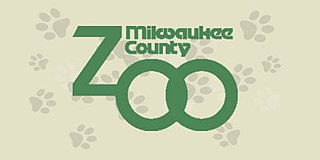
The Milwaukee County Zoo is a zoo in Milwaukee, Wisconsin, operated by the Milwaukee County Parks Commission and is accredited by the Association of Zoos and Aquariums. The zoo averages about 1.3 million visitors a year. The zoo houses 3,100 animals from 350 species and covers an area of 190 acres (77 ha). The zoo is noted for the second birth of polar bears and siamangs in captivity and for their locally famous gorilla Samson, who lived from 1950 to 1981 and whose bones are now on display at the Milwaukee Public Museum. During World War II, a celebrity animal of the zoo was Gertie the Duck and her ducklings. The zoo is also home to one of the largest group of bonobos in one location outside their native Democratic Republic of the Congo, and has two cheetahs from the National Zoo in Washington, DC.
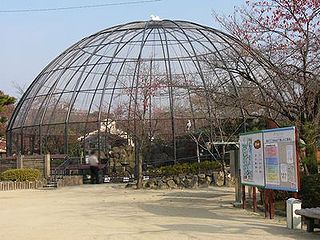
Kyoto City Zoo (京都市動物園) is a zoo located in Sakyō ward, Kyoto and was established in 1903, making it the second oldest zoo in the country after Ueno Zoo in Tokyo.

The ZooParc de Beauval, more commonly called Beauval Zoo or, more simply, Beauval, is a French zoological park located in Saint-Aignan-sur-Cher, Centre-Val de Loire. It features more than 35,000 animals on 40 hectares, which is one of the largest animal collections in France and in Europe. Created in 1980 by Françoise Delord, it is now run by her son, Rodolphe Delord, and managed by his family, which owns most of the capital.

The Karlsruhe Zoo is a city garden with a zoo in the southwest of Karlsruhe, Germany. It also encompasses the outer area; Tierpark Oberwald in the southeast of the city. The main area totals 22 hectares, and the Oberwald Zoo has an area of 16 hectares. A total of around 3000 animals of over 240 species live at the Zoologische Stadtgarten Karlsruhe. The city garden is located north of the Karlsruhe Hauptbahnhof and south of the Karlsruhe Congress between the Karlsruhe districts of Südstadt and Südweststadt. The zoo was opened in 1865, making it one of the oldest zoos in Germany. The city garden and zoo form a common, enclosed area and cannot be visited separately.

Rostock Zoo is a zoo in the city of Rostock, founded in 1899. It covers 56 hectares and with 4,500 animals from 320 species, Rostock Zoo is the largest zoo on the German east coast. Rostock Zoo is studbook keeper of Polar bears within the European Endangered Species Programme. The director of Rostock Zoo is Udo Nagel.

Zoo Osnabrück is located in south Osnabrück at the hillside of Schölerberg in Osnabrück, Germany. It was founded under the name "Heimattiergarten", and opened during the summer of 1936. Almost 3000 animals from roughly 300 species can be seen on the 23.5 ha (0.235 km2) land. It is famous for housing the Grolar Bear. This brought about many scientific inquiries into the zoo.

Magdeburg Zoo is a zoo in the city of Magdeburg in the region Sachsen-Anhalt, Germany. The zoo was founded in 1950, and covers 16 hectares.

The Saarbrücken Zoo is with over 200.000 visitors annually, and over 1.700 animals from 160 Species the largest Zoo in Saarland. The Zoo is specialized in African animals.
